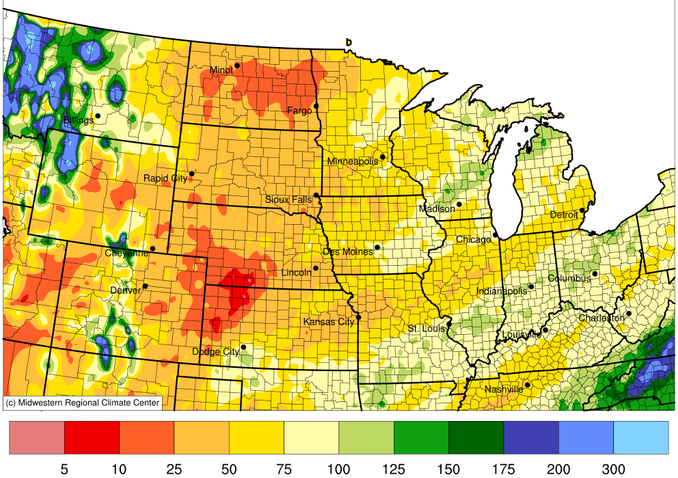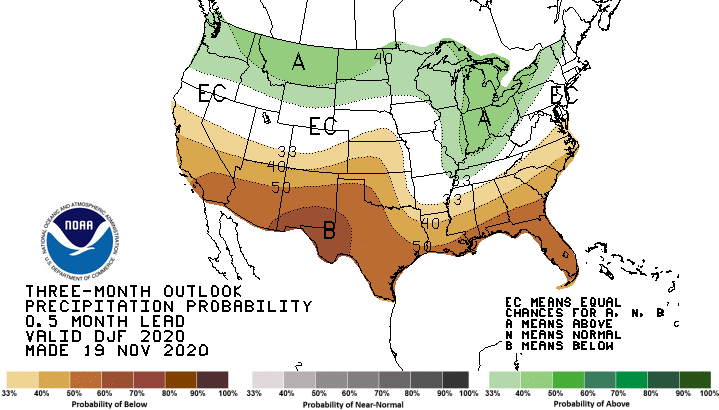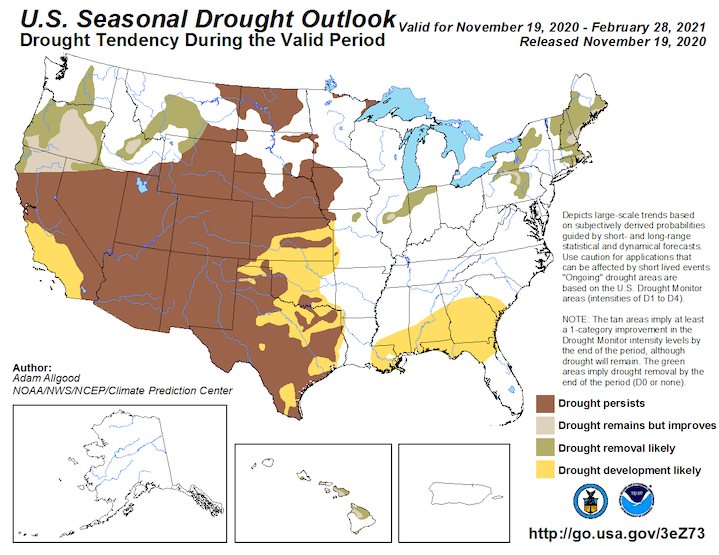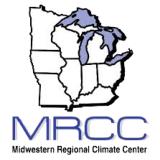For the latest forecasts and critical weather information, visit weather.gov.
Drought Conditions Likely to Persist through Winter Season
- Drought intensified this fall in many areas, and as of the December 8 U.S. Drought Monitor map, around 44% of the central U.S. was in drought (from moderate to exceptional), with an additional 23% in the abnormally dry category.
- While areas in the central U.S. might receive above-normal precipitation this winter, it will likely not be enough to alleviate drought conditions, particularly in areas with severe to exceptional drought (D2-D4) currently.
- Soil moisture will likely remain abnormally low heading into the spring season, which could leave the central U.S. more susceptible to drought intensification moving into the 2021 growing season, particularly if the spring season doesn't bring near-normal precipitation.
- Existing drought issues (inadequate soil moisture for growing or dormant vegetation, poor pasture conditions, low water supply for livestock and municipal use, fire risk) are likely to continue throughout the winter and into the spring.
Current U.S. Drought Monitor map for the National Weather Service Central Region with data valid for December 8, 2020. The U.S. Drought Monitor (USDM) is updated each Thursday to show the location and intensity of drought across the country. Drought categories show experts’ assessments of conditions related to dryness and drought including observations of how much water is available in streams, lakes, and soils compared to usual for the same time of year.
U.S. Drought Monitor Categories
Current U.S. Drought Monitor map for the National Weather Service Central Region with data valid for December 8, 2020. The U.S. Drought Monitor (USDM) is updated each Thursday to show the location and intensity of drought across the country. Drought categories show experts’ assessments of conditions related to dryness and drought including observations of how much water is available in streams, lakes, and soils compared to usual for the same time of year.
Current Conditions and Impacts
- Drought intensified this fall in many areas, and as of the December 8 U.S. Drought Monitor map, around 44% of the central U.S. was in drought (from moderate to exceptional), with an additional 23% in the abnormally dry category.
- The areas of greatest concern are those currently with exceptional drought, such as western Colorado, and areas with extreme drought (D3), as in Colorado, Iowa, Kansas, Nebraska, North Dakota, South Dakota, and Wyoming.
- Precipitation over the last 90 days has been below normal across much of the central U.S., leading to the persistence of below-normal soil moisture at the surface and at deeper levels.
- Early December drought impacts include inadequate soil moisture for winter wheat and other vegetation (growing or dormant), poor pasture conditions, low water supply for livestock, municipal and rural use, increased fire risk, and reduced snowpack leading to recreational and tourism impacts.
- Drought mitigation measures thus far have included early supplemental feeding, transporting or culling of livestock, municipal water restrictions, deepening of wells, full activation of Colorado’s state drought response plan, and burn bans.
Precipitation Percent of Normal: September 15 - December 14, 2020

MRCC's cli-MATE: https://mrcc.illinois.edu/CLIMATE/
Outlook and Potential Impacts
- Northern portions of the region have greater chances for above-normal precipitation over the winter (December-February).
- However, even if above-normal precipitation is received, it will likely not be enough to alleviate drought conditions, particularly in those areas with severe to exceptional (D2-D4) drought in the western portions of the region. This is primarily due to the fact that this is the driest time of the year for many of these areas, and once frozen, soils are unable to recharge.
- Winter precipitation could bring some relief to drought conditions in Illinois and Indiana, and abnormally dry conditions in the Ohio River Basin.
- Soil moisture will likely be abnormally low heading into the spring season, which could leave the central U.S. more susceptible to drought intensification moving into the 2021 growing season. It will be critically important to receive at least near-normal precipitation during the spring season to lessen drought risk.
- Existing drought issues (inadequate soil moisture for growing or dormant vegetation, poor pasture conditions, low water supply for livestock and municipal use, fire risk) will likely continue throughout the winter and into the spring.
- La Niña conditions were considered in the outlook, as this typically brings enhanced changes of wetter-than-normal conditions in the Ohio River Basin, particularly for late winter.
Precipitation Outlook: December 2020 - February 2021

Current CPC Outlooks: https://www.cpc.ncep.noaa.gov/
Seasonal Drought Outlook: November 19, 2020 - February 28, 2021

Current CPC Outlooks: https://www.cpc.ncep.noaa.gov/
For More Information
- NIDIS and its partners will issue future updates as conditions evolve.
- More local information is available from the following resources:
- There are also upcoming webinars that will offer more information:
- December 17th - North Central U.S. Climate and Drought Summary & Outlook Webinars (offered monthly)
- La Niña Impacts and Outlooks 2020 Report for the Midwest and Missouri River Basin.
- Midwest and Missouri River Basin Climate Impacts & Outlook Quarterly Reports will be released the week of December 21st.
Prepared By
Molly Woloszyn & Britt Parker
NOAA/National Integrated Drought Information System (NIDIS)
Dennis Todey & Dannele Peck
USDA Midwest and Northern Plains Climate Hubs
Doug Kluck
NOAA/National Centers for Environmental Information
Ray Wolf
NOAA/National Weather Service
Natalie Umphlett
High Plains Regional Climate Center
Mike Timlin
Midwestern Regional Climate Center
In partnership with the National Drought Mitigation Center (NDMC) and American Association of State Climatologists (AASC).
This Drought Early Warning Update is issued in partnership between the National Oceanic and Atmospheric Administration (NOAA) and the U.S. Department of Agriculture (USDA) to communicate a potential area of concern for drought expansion and/or development within the North Central U.S. based on recent conditions and the upcoming forecast. NIDIS and its partners will issue future Drought Early Warning Updates as conditions evolve.








